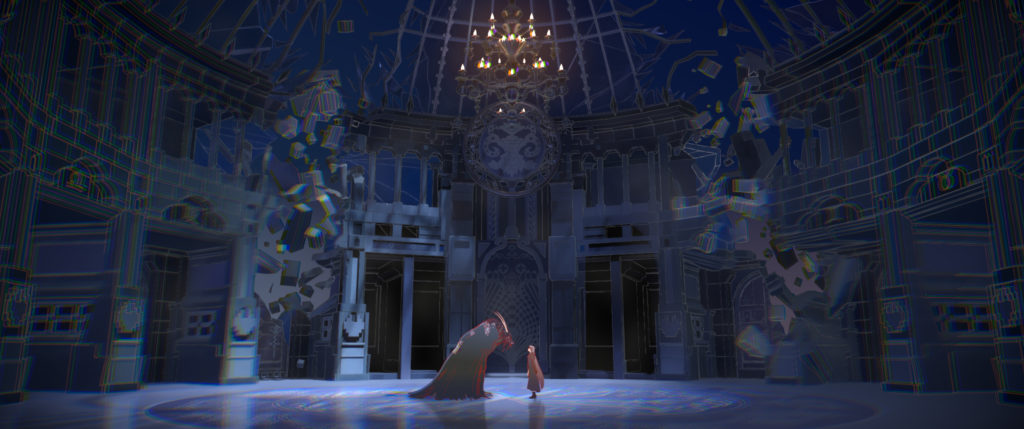The Ira Holmes International Film Series hosted their first pre-season event of the 2024-2025 season with a screening of “Belle”. “Belle” (2021) stood out as an anime masterpiece that draws the audience in with its breathtaking animation, stellar music, and compelling voice performances—even when the storyline falters. Directed by Mamoru Hosoda, “Belle” offers a modern retelling of “Beauty and the Beast” within a futuristic, virtual world called “U”, where characters’ inner struggles mirror their digital avatars.
“Belle” Review
Suzu’s world is a modern Japan, where she lives in rural Kochi Prefecture. Although not as grand as “U”, the art style and look within the “real” world still has a meaningful impact to the story. Opposing the endless beauty of “U”, Suzu’s world features normal buildings and characters that could be found in the “real” world. This differentiation calls to life the real impacts Suzu faces when she brings herself out of the virtual world.
Within “U”, the virtual world where Belle thrives with her voice, there is a cinematic beauty to every scene. There is a vast landscape with buildings and characters that creates a depth, making the world feel endless, similar to the endlessness of the virtual world the audience is familiar with. The endless possibility of design also allows for beautiful architecture and character styles that wouldn’t otherwise be found in the real world. The character designs are also vastly different from Suzu’s world where Belle is what Suzu believes, is a better image of herself.
Equally impressive is the music, which weaves seamlessly into the story. The soundtrack – featuring a mix of electronic beats and sweeping orchestral compositions – elevates the emotional impact of the film, giving key scenes a sense of grandeur and urgency. The songs performed by Belle, the protagonist’s avatar, are especially powerful and leave a lasting impression.
The film’s greatest strength lies in its visual splendor. From the vibrant landscapes of “U” to the delicate, painterly details of its characters, the animation is a feast for the eyes. Every scene feels like a painting in motion, making it impossible to look away. The film’s use of vibrant colors and soft, yet fluid animation helps patch up any loose ends in the narrative, but more effectively highlights each character’s emotion and is utilized to showcase the differences between the real world and the virtual world of “U”. The use of colors and style of animation also help reflect the emotions felt by the characters. A colorful, bright and vibrant background is used when Suzu begins singing as Belle in “U”, feeling relief and happiness. The opposite is also reflected in the somber moment she finds the “Beast” in his castle with cool-toned dark and less vibrant colors.
Although there is plenty of strength in the art, a fault that the characters often had, at least in Suzu’s world, is the still animation of the characters faces. It provided comedic moments and showed some hesitation in character. However, it also made for weak transitions between characters who looked suspended in time and could easily pull the audience out of the immersion.
Suzu has trouble singing in her world and gets sick every time she tries, despite how much she wants to. However, “U” picks up on this insecurity and allows her character to sing beautiful and powerful melodies that provide a small snippet of insight into her life. In a time of need, when two kids are in dire trouble, the film depicts Suzu’s newfound strength and confidence in herself, which allows her to sing as Suzu, not Belle, in the final act of the film. Suzu’s time as Belle allows the film to take a different route when tackling the overall theme of the impact of the Internet. The film holds a neutral standpoint, showing that the Internet can be a place to enact change in the world, whether it’s good or bad.
Belle doesn’t shy away from deeper emotional experiences and strong character development. “U” takes the personification of characters’ best features and applies them to their avatars. This highlights that the insecurities that Suzu believes she has, are not as prominent as she believes. These changes led her to becoming a happier, more confident person with a changed outlook on life and a new attitude towards some aspects of her life. Beast is no exception to “U’s” algorithm. Like, Belle, Beast is displayed with his strongest and best characteristics as a large, bulky dragon (which, in Japanese culture, symbolizes power, luck, wisdom). The look of his character repelled people and he was insecure about the features he was provided with, despite having all the qualities of a protector. This shows that despite his insecurities, fears and being a child, he is wise and strong beyond his years. Although Beast was not used to kindness and didn’t believe Suzu when she said she was Belle, through “U” and Belle, he learned to accept kindness and restored his faith in humanity, despite the trauma he had experienced.
The voice acting also stands out. Whether you’re watching in its original Japanese or the English dub (a translation of a film from its original source to another language), the voice actors bring life to the characters in a way that feels genuine and moving. Their performances are crucial to connecting with the complex emotional arcs of the story, especially when it starts to meander in its later acts.
Belle stumbles slightly in its plot. The film ambitiously tries to balance a multitude of themes—loss, identity, love, and the blurred lines between reality and the digital world—but in doing so, some of its emotional beats don’t hit as hard as they should. One of the film’s common blunders is that it sometimes swaps comedy or action-filled scenes with a quick and rough transition to deeply emotional and impactful moments. However, the characters and their relationships are strong enough to keep you invested throughout, making the occasional narrative stumble forgivable.
Ultimately, Belle is a cinematic experience worth seeing for its innovative visuals, stellar music, and heartfelt performances. Despite its, sometimes, uneven storyline, the film captures the beauty of self-expression and the complexities of human connection in a digital age.
More Film Series Information
To watch more innovative and immersive films, keeping up with Ira Holmes International Film Series is a great way to do so. Due to Hurricane Milton, the screening of “The Seventh Seal” has been cancelled while the Ira Holmes dedication ceremony has been postponed until further notice. However, the screening of Alfred Hitchcock’s “Psycho” is still taking place on Oct. 22 at the Marion Theatre at 50 S Magnolia Ave, Ocala, FL 34471 at 7:30 p.m. with a music talk from Ocala Symphony Orchestra Music Director, Matthew Wardell. The film will also be displayed at the Appleton Museum of Art at 4333 E Silver Springs Blvd, Ocala, FL 34470 from 2-4 p.m. To learn more about the series, film and Ira Holmes, visit Ira Holmes International Film Series website.





